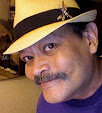Okay, now the first poem in the book. (Note: there's a navigation bar below each Dragonfly post that can help you move around in the book posts in the blog.)
Page 1
First Hand-Plant: Skating the Petaluma Ramp — for my son Marty The front wheels kiss the edge and
my son pauses for a breath then drops in
and for once his Vans don't slip
on the skateboard's sandpaper grip tape,
a flawless slide down plywood,
the face of the ten-foot half pipe
thundering with the whine of tortured
ball bearings, and now like the Silver Surfer
slicing through angular air, he climbs
the opposite slope, as thrasher buddies
and posers hook their eyes on his goofy-footed
profile arcing against California sky, then down
he drops again, the reverse swing
of a chainless pendulum, love
affair with gravity and breakneck
speed, climbing now once more,
his board pointed toward the hard light
above the metal lip of the ramp, and
his right hand reaches down
between both shoes to grip the board
as his left snakes out to plant
the hand on the rim, then
lock wrist and elbow,
pausing upside down like a pole vaulter
Page 2
This poem brings me back to grad school at Indiana University, 20-plus years ago, when Marty would come and visit, stay for the summer. Mary Ann and I were newly-weds, and Marty was 12, 13, etc. The first summer — I think Marty was probably 11 — Mary Ann called her mom and said, "What do I do? He's eating everything!" Mom said, "Remember when I used to feed you and your brothers spaghetti and really filling food like that?" Ah, teenagedom.
What I remember most about those summers was Marty's utter devotion to skateboarding. No, I should use the skateboarder's preferred term: skating. And not skateboarders, but skaters. Marty found other skaters at the local skatepark with its rails and small ramps; they called him "The California Kid." He would eat a little breakfast and then skate all morning. Back home for lunch. Skate all afternoon. Home for dinner. Then evenings poring over Thrasher and Skateboarding magazines — new issues as well as dog-eared, thumb-worn, precious back issues he'd lugged from California. Or else watch skating videos: Tony Hawk and Steve Caballero, Mike McGill and the Bones Brigade. Hours drawing intricate skull-and-skeleton-themed graphics,
Marty would skate so early in the morning, out in the parking lot of our high-rise married-student-housing apartment, that once we had an awkward moment in the elevator when another resident saw Marty's skateboard and blurted out, "Oh, so you're the one who's been waking us up every morning with that skateboard!" Ah yes, skateboard noises: click-clack, grrrrind, sh-clank! The soundtrack of Marty's world back then.
"First Hand-Plant: Skating the Petaluma Ramp" is my homage to Marty's obsession. Marty was always a street skater and so hardly ever did tricks on half-pipes (the double-walled large ramps), but I was just amazed by hand-plants, which I saw over and over in Marty's videos. Vert skating, as ramp work later came to be known, connected with my fantasies of flying, and in this poem, I tried to capture and dramatize how I imagined it would feel to pull off a hand-plant.
For you poets and scholars who are interested in poetics, this poem started off as an homage to and imitation of Edward Hirsch's poem Fast Break — hence the couplets, the words "drop" and "for once" early in the poem, the single sentence overall. "First Hand-Plant" really took off in its own singular direction, different from Hirsch's impetus, so I never published this as "after Edward Hirsch." But looking at it now, it seems quite faithful to "Fast Break," so let give props right here: thanks for the inspiration, Ed, and the tremendously useful form. In your case, couplets like two forwards fast-breaking down-court, in my case, couplets like skateboard wheels in tandem, whirring in air during the frozen moment at the top of the parabola.
In "First Hand-Plant" I use quite a lot of enjambment:
There is also quite a bit of soundplay. For example, the consonance of /p/ sounds in the first two or three stanzas: pauses, drops, slip, sandpaper grip tape, plywood, pipe. That last word "pipe" is of course half of an important phrase in the poem, "half pipe," which also contains the related consonant /f/. Check out the occurrences of /f/ in those same three stanzas: front, for once, flawless, ten-foot, half. Even the title of the poem visibly features /f/ and /p/.
A Filipino critic and scholar might be tempted to point out here that in Philippine languages, /f/ does not exist and so Filipinos learning English and/or Spanish mix up /f/ and /p/, and that that is why the /f/ and /p/ conjunction is appearing in this poem. A claim like that might be reaching too far, but who knows? It's entirely possible that the /f/ vs. /p/ stuff could be there in some very deep, intimate layer of my "poetry machine."
The more expected consonants — /s/ and /r/ — appear throughout the poem but most conspicuously in the last three stanzas: moment's, takes, as, angles, swooping, steep, steals, scouting, then crazy, rigid, rock and roll, gravity, board, earth, right, country (and of course one sees both in shoulder, said twice).
There is plenty more that could be said here, but I'll leave some fruit for others to pick. Break out that old skateboard from the garage! Get out there and skate. Then come back and read some more right here. Peace out.
NOTE: The photo above is of Steve Caballero executing a hand-plant, from Skateboard-World, a site by sk8rnick.
|







1 comment:
Am i allowed to use this photo to include it into an poster?
Post a Comment